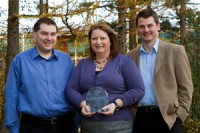
The Edinburgh Physics Education Research Group (EdPER) has won the Formative e-Assessment category at this year's Scottish e-Assessment Awards.
The entry, submitted by the School's Simon Bates, Ross Galloway and Karon McBride, described assessed assignments that use PeerWise, an online question sharing and peer review application developed by the University of Auckland.
'Using PeerWise for Formative Peer e-Assessment in Introductory Physics Courses' reported on the successful use of scaffolded tasks in two introductory-level physics courses. Instructional scaffolding gives students additional support when new concepts are first introduced, with the support gradually reduced as student learning progresses.
"The biggest benefit was writing questions and having to put a lot of thought in to explain the problem to other people. It really helped my understanding of parts of the subject." Student workshop participant
The EdPER team developed four scaffolding activities for workshops preceding PeerWise assignments. The initial scaffolding activity was well received, with class leaders reporting a notable 'buzz' during the workshops and many students opting in subsequent workshops to use PeerWise to work collaboratively during break times.
In the post-course survey of students, 65% agreed that developing original questions improved their understanding of course topics. One student wrote: "The biggest benefit was writing questions and having to put a lot of thought in to explain the problem to other people. It really helped my understanding of parts of the subject."
About EdPER
EdPER is a group of School staff and students that aims to adopt a more scientific approach to Physics and science teaching. The group undertakes evidence-based research into aspects of physics teaching and learning at university level. Our aim is to develop and evaluate research-based instructional strategies, by gathering and analysing both quantitative and qualitative data, with a view to being able to improve student learning in the subject and related cognate areas.
The group was formally established in 2008 and comprises staff from across the various institutes within the School, together with postgraduate students, e-learning developers and learning designers. Some highlights of our recent work have been in the area of developing a diagnostic test of data handling skills and the incorporation of student generated assessment content in introductory courses.
To learn more, speak to Karon McBride, Learning Designer: karon.mcbride [at] ed.ac.uk
The Scottish e-Assessment Awards
Launched in 2009, the Awards recognise excellence and innovation in using e-Assessment to improve the educational experience of learners. More than 50 entries were received in 2011. The judging panel was made up of members of the Board of the UK's e-Assessment Association and Soffed (a partner in the running of the Awards in Scotland). The award was collected at eAssessment Scotland 2011 in Dundee.
Image gallery
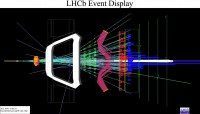
The LHCb experiment in CERN - in which the School takes a leading role - is exploring processes important to the understanding of what happened fourteen billion years ago, when the Universe began.
Crammed within an infinitely small space, equal quantities of matter and antimatter were created. But its composition changed as the Universe cooled and expanded: just one second after the Big Bang antimatter had all but disappeared, leaving only matter to form everything that we see around us.
This matter-antimatter asymmetry relies upon a phenomenon known as CP violation. It is predicted by the Standard Model of Physics but at a much lower level than we need to explain the early Universe.
The LHCb experiment measures the decay of elementary particles known as B mesons, and in this case a quantity known as φs. Experimental results which deviate from the Standard Model's predictions would suggest new physics sources of CP violation. Fermilab in the USA has previously measured φs, but the LHCb detector at the Large Hadron Collider has improved the precision by a factor of two with preliminary results and will soon improve this by a factor of ten. These new results, which were eagerly awaited, were announced at the 'Lepton Photon' conference in Mumbai in August.
"This is a milestone for the LHCb experiment. It is a flagship result for LHCb, where we have now made the World's most precise measurement of this quantity." Peter Clarke, Institute for Particle and Nuclear Physics
Peter Clarke, of the School's Institute for Particle and Nuclear Physics, said: "This is a milestone for the LHCb experiment. It is is a flagship result for LHCb, where we have now made the World's most precise measurement of this quantity. A team of seven physicists and PhD students from the University of Edinburgh was one of the groups leading the measurement of φs by analysing decays of Bs mesons into J/psi and phi mesons.
"Measuring φs is all about understanding the origin of difference in behaviour of matter and antimatter. This difference is a key ingredient in the evolution of the early Universe. Without it we would have no 'matter' left today and we wouldn't be writing this article.
"We know that the matter anti-matter difference in our Standard Model is insufficient to explain the Universe. So we are looking to find evidence of new sources of this effect, ie discover new physics phenomenon. This is the big motivation for us all."
The Standard Model, quarks and the missing anti-matter
Matter and antimatter are thought to have existed in equal amounts at the beginning of the Universe, but as the Universe expanded and cooled, an asymmetry developed between them, leaving a universe that appears to be composed entirely of matter. Heavy quarks provide a good place to investigate this phenomenon because the heavier the quark, the more ways it can decay, and all of these decays are described by the Standard Model.
The Standard Model predicts matter-antimatter asymmetry, but at a level which is too small to explain the observed asymmetry in the Universe. Deviations from the predictions would bring an indication of new physics. b-quarks are produced copiously at the LHC, which makes them the particle of choice for studying matter-antimatter asymmetry in the laboratory. Quarks are never produced alone, but always travel in company: they are accompanied by another quark giving rise to the family of particles called B mesons. It is these that LHCb studies.
Image gallery
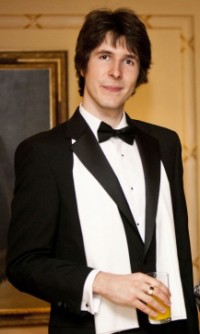
Computational Physics student Flaviu Cipcigan reached the final of the Science, Engineering & Technology (SET) Student of the Year Awards with his work on Quantum Computing. Here he tells us what was involved.
It all started with my Computational Physics Junior Honours Project, where I had the opportunity to learn about Quantum Computing and its applications. My interest in Quantum Computing continued after the project, leading to an EPSRC (Engineering & Physical Sciences Research Council) vacation scholarship and a Senior Honours Project, both under the supervision of Dr Elham Kashefi and Prof. Tony Kennedy. In these projects, I looked at the theoretical and experimental aspects of the subject (the latter in collaboration with Dr Philip Walther and Ms Stefanie Barz, University of Vienna), gaining a broad understanding of its present state and the direction it is heading in.
Based on the latter two projects, Dr Kashefi nominated me for the SET Awards. The first round consisted of a short report detailing what was involved in the projects and their importance. This took me to the final round of the Awards, where three students from each category were invited to give a presentation at the Institute of Physics in London. The award ceremony was organised in the evening of the interview and was my personal highlight of the SET Awards, as I had the opportunity to talk to a wide range of great academics and industry leaders.
I was very honoured to represent the schools of Physics and Informatics at such a unique event and to highlight the importance of collaborations between disciplines. Quantum Computing is a great medium for this, since its challenges can only be solved with input from both disciplines, both of which are close to my heart.
Image gallery

Student entrepreneur wins a place at Stockholm International Youth Science Seminar and the Nobel festivities.
Science and business are often seen as two separate spheres, but as Physics student Eimear O' Carroll explains, when you combine the analytical and problem solving skills of a scientist with a commercial opportunity it can be a recipe for success.
Restored Hearing Ltd produces an innovative sound therapy for sufferers of temporary tinnitus that is effective in just one minute. Using the physics of sound and how the ear responds to different types of sound, we have developed a non-invasive remedy for the ringing in your ears commonly experienced after concerts or listening to your iPod for too long.
Originating as a project for the BT Young Scientist and Technology exhibition, the Restored Hearing team comprises Rhona Togher and myself, who were two students on the project, and Anthony Carolan, the project mentor at the time. We won Runner Up Overall and the Health Research Board Award for Medical Innovation in 2009. When investigating funding for further research it was suggested that we market the therapy. We incorporated the company in May 2009, a month before our final high school exams, and Restored Hearing was born.
I have found running a business to be an extremely exciting and rewarding endeavour, if a bit stressful at times when university and working life clash.
Having fallen into entrepreneurship by accident I have found running a business to be an extremely exciting and rewarding endeavour, if a bit stressful at times when university and working life clash. I started working with Launch.ed, the University of Edinburgh student enterprise support service, last year and it has been an integral part of the development of Restored Hearing and my skills as an entrepreneur. My involvement with Launch.ed has led to developing winning business pitches, expanding my network and going to South Korea for the MIT Global Start-Up Workshop on its inaugural scholarship programme.
Rhona and I recently represented Ireland in the Intel/JAYE Sci-preneurship competition in Brussels. Ten international teams were given 24 hours to develop a business idea from scratch that was socially beneficial while being commercially viable. Second place was awarded to Rhona’s team for their noise reduction technology while I was awarded a place at the Stockholm International Youth Science Seminar. In December I will be travelling to Stockholm to present Restored Hearing and attend the Nobel lectures and the Nobel Prize ceremony.
We sell the Somtus TM therapy online and have spent the past two years developing the website, gaining national and international publicity for the company (including articles by the Institute of Physics and ABC News) and using physics to solve auditory problems.
Image gallery
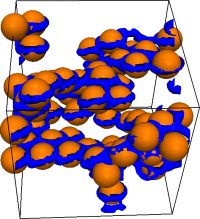
A new type of soft gel developed by School researchers may have important implications for the future use of liquid crystals.
Conventional wisdom says that particles and liquid crystals do not mix. In the latter state of matter, anisotropic molecules (which have direction-dependent properties) align to form various 'mesophases'. The simplest mesophase is the nematic, in which rod shape molecules all point in the same direction. The inclusion of particles disrupts such ordering, and gives rise to energetically costly 'defects' known as disclinations. In the past, therefore, it has proved all but impossible to coax anything more than a handful of particles to disperse in liquid crystalline mesophases.
Now, researchers from the School's Institute of Condensed Matter and Complex Systems have managed to persuade the nematic phase of a well-known liquid crystal to mix with a high concentration of particles. The resulting material is a solid gel. 'Solidifying' liquid crystals this way may have important implications for their application. Liquid crystals are already widely used in display devices, and are increasingly seen as possible biomedical sensors. But liquid crystals flow like liquids, and so hitherto, there is always the need for an external container. The invention of liquid crystalline gels removes this constraint.
Extensive computer simulations allowed the ICMCS researchers to show that the new liquid crystal gel they had made in the test tube derived its rigidity from the disclinations entangling each other and trapping a percolated particle network (see figure, where particles are orange spheres, and disclinates are blue lines). Interestingly, this arrested state of matter has similarities with 'vortex glasses' in Type II superconductors, and may open up new avenues for understanding 'glassy arrest', which remains one of the deepest problems in condensed matter science.
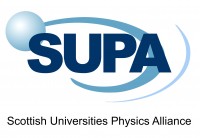
The SUPA Graduate School has instigated Distinguished Visitors and Events Support Programmes. Their purposes are threefold:
- to enhance the training of physics graduate students within SUPA
- to enhance the dissemination of research to and from SUPA
- to enhance SUPA research strength.
SUPA is calling for applications for these two programmes. Applications should be submitted to admin [at] supa.ac.uk by Friday 11th November 2011. All applications will be reviewed and decided upon by the Graduate School Management Committee.
Please also read the guidelines to applying. Applications which do not conform to these guidelines will not be accepted.
Distinguished Visitors Programme
The scheme will fund short visits to Scotland by renowned scientists from elsewhere in the world.
Prospective visitors should be based at one (or more) of the SUPA Graduate School institutions during their stay, and will be expected to provide specific benefits for the training of graduate students and/or research. These benefits might include some or all of the following: taking part in or helping to direct research via generation of new ideas, sharing of expertise by giving short lecture courses, guest lectures and colloquia. Visits to SUPA institutions other than the host institution(s) are strongly encouraged.
Event Support Programme
The scheme can contribute to appropriate Postgraduate Schools, Workshops, and Technical Meetings held in Scotland and organised by members of the SUPA Graduate School.
The proposed event will be expected to provide specific benefits for the training of graduate students. Meetings or workshops with a primary aim of graduate student training will be targeted for support. Likewise, technical meetings that provide graduate student level introductions, or that are making other special provisions to encourage graduate student attendance and participation will be considered.
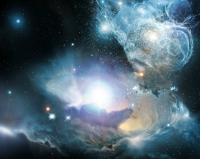
The Euclid mission, which aims to understand the origin of the accelerating expansion of the Universe, has been selected by the European Space Agency's (ESA) Cosmic Vision Programme.
The Euclid satellite will observe 1.5 billion galaxies in an effort to track the effects of dark energy, dark matter and gravity on the expansion and growth of cosmic structures in the Universe over the last 10 billion years. At the heart of Euclid is a massive optical digital camera - one of the largest such cameras put into space. Every 15 minutes it will produce an image that is the equivalent of nearly 300 HDTV screens, and in six years it will have surveyed 75 per cent of the sky. ESA plans to launch the Euclid satellite in 2019.
"Euclid is a wonderful step for European and UK science," Professor Andrew Taylor
Euclid and the Institute for Astronomy
The School's Institute for Astronomy (IFA) is heavily involved in several aspects of the mission, with the UK Euclid Science Data Centre to be based at the Royal Observatory (ROE), and run by the IFA’s Wide Field Astronomy Unit.
Professor Andrew Taylor, Professor of Astrophysics at the University's Institute for Astronomy, leads the UK Ground Segment for Euclid, responsible for coordinating the UK’s Euclid data analysis. He also leads the measurement of the Weak Gravitational Lensing signal – one of Euclid's two main science probes which will map the dark matter and probe dark energy – which will also be carried out in Edinburgh. "Euclid is a wonderful step for European and UK Science," said Professor Taylor. "Dark energy and dark matter are two of the biggest problems in Cosmology and Physics today, and Euclid will bring us much closer to explaining them. Edinburgh has a big part to play in this."
Thomas Kitching, a Royal Society Research Fellow at the IFA, is one of four European leads of the Euclid Science Group (a team of over 800 scientists) and co-leads the Weak Lensing science group. He said: "Euclid will image the sky with the same quality and depth as the hugely successful Hubble Space Telescope but over an area of sky thousands of times larger, producing so many images that it would take a million USB sticks to store the information."
"By imaging the majority of galaxies in our observable Universe, Euclid will unveil the mysteries of dark energy and gravity, revolutionising physics for decades to come." Thomas Kitching, IFA
About Euclid
Euclid is designed to understand the origin of Universe's accelerating expansion that physicists and astronomers refer to as "Dark Energy". Current observations show that dark energy comprises more than 70% of the matter-energy of the present-day Universe and is therefore driving its evolution.
To achieve this, it is proposed to build a satellite equipped with a 1.2 m telescope and three imaging and spectroscopic instruments working in the visible and near-infrared wavelength domains. These instruments will observe several hundreds of million galaxies over a large fraction of sky and will track the observational signatures of dark energy, dark matter and gravity on the geometry of the Universe and the cosmic history of structure formation. By measuring the apparent shapes and the distribution of galaxies in the Universe, astronomers will then derive what is dark energy and whether the general theory of relativity is still a valid gravitation theory on scales beyond billions of light years.
Euclid is planned for launch in 2019, with ESA funding the spacecraft, launch and operations. The UK and other national partners (Austria, Denmark, Italy, Finland, France, Germany, Netherlands, Norway, Romania, Spain, Switzerland) will fund the scientific instruments and the ground segment activities.
Nine UK institutions are involved in Euclid’s instrument development or data/processing/analysis activities: University College London; University of Durham; the Institute for Astronomy in Edinburgh; UK ATC; University of Oxford; University of Portsmouth; University of Hertfordshire; the Open University and the University of Cambridge.
In addition, many scientists across the UK are involved in the scientific definition of Euclid and will have access to the data. Across Europe, the Euclid consortium contains over 800 scientists from 110 institutions.
Image gallery
The SOUND exhibition combines soundscapes and artwork to examine how we are affected by industrial and urban noise. It has toured in the UK, India and Belarus and is currently installed in the Briggait Centre in Glasgow, where it was visited by over 1,000 people in the opening weekend.
The exhibition features a new semi-anechoic installation with surround sound and a binaural soundscape to reproduce the experience of hearing 'live' sounds. There is also a new video about sound made in the School of Physics and Astronomy.
'SOUND in a Man-Made Environment' is funded through the School of Physics and Astronomy by the Engineering and Physical Sciences Research Council. The Glasgow exhibition runs until October 10th.
More details about the exhibition and a list of the venues where it has been shown can be found on the SOUND website - see below.
Image gallery
Four academics in the School of Physics & Astronomy are among the first members of the Royal Society of Edinburgh's new Young Academy of Scotland.
Rosalind Allen, Cait MacPhee, Job Thijssen (all from the Institute for Condensed Matter and Complex Systems) and Catherine Heymans (Institute for Astronomy) will join 64 other academics, entrepreneurs, artists and professionals in the first venture of its kind in the UK.
The Young Academy brings together some of the most able people in Scotland, with the intention of stimulating creative ideas and collaborative working. It will also provide a forum for its members to engage with talented individuals beyond their own discipline or profession.
"I'm delighted to have been chosen as one of the first members of the Young Academy. Its ambitious goals will address many of the challenges facing society today and I'm very much looking forward to contributing to its work." Catherine Heymans.
"The Academy will support young academics in Scotland as well as reaching out beyond academia. It's great that the School is so well represented and I'm excited to be involved." Rosalind Allen.
"The Young Academy of Scotland will provide a unique platform for tackling complex issues which require an interdisciplinary effort, for example the energy challenge and climate change. I am very much looking forward to the new collaborations that it will encourage and to becoming more active in science policy and public engagement." Job Thijssen
The RSE Young Academy invited applications from outstanding young academics and professionals whose ages range from late 20s to early 40s. A wide variety of expertise is represented by its members, from biologists, geoscientists and engineers to lawyers, social scientists and entrepreneurs.
The Academy's members come from all parts of Scotland, and every year a new round of applications will be encouraged, bringing in a new cohort of members. Membership lasts for 3 years and can be continued for a further 3 years. In the first cohort, 68 people have been selected from 336 applicants. Of these over 40 % are female. About 80% are drawn from academic institutions, with around 20% from the professions and business.
The Young Academy of Scotland will be launched at a ceremony in Edinburgh in November.
Image gallery
Computer chips developed for gaming have the potential to create more realistic synthesised music.
Graphical Processor Units (GPUs) can be used to create more realistic synthesised music than has previously been possible. This is what Chris Maynard, a computer scientist at EPCC, claims will move along sound synthesis techniques, which have remained stagnant for decades.
Read the full article in ISGTW.

